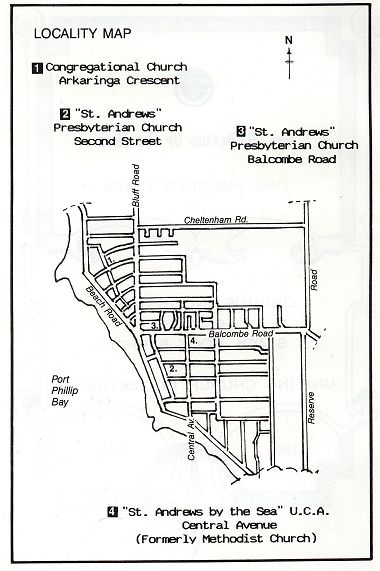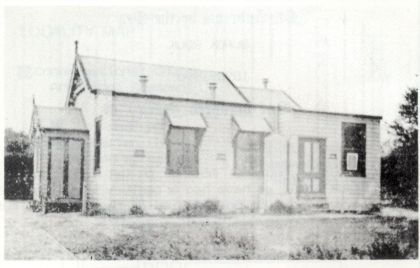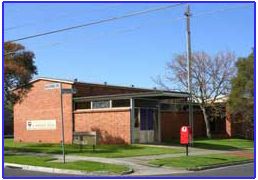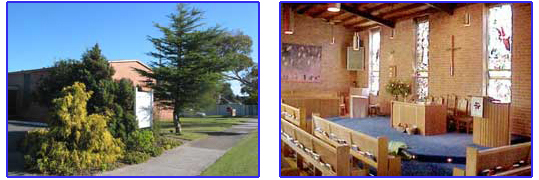St Andrews by the SeaOne Hundred Years
|
| Receipts | (collections etc.) | £ 43. 1. 4 | |
| Expenses: | Organ | £ 16.17. 6 | |
| Furniture | £ 7. 7. 9 | ||
| Land | £ 51.10. 0 | ||
| Bell | £ 2. 2. 0 | ||
| Ploughing the land | £ 2. 0. 0 | ||
| Total Expenses | £ 89. 2. 5 |
A report in "Congregational News" on 19th April 1906 tells of a slow but steady growth at Black Rock and that the property is debt free.
The Sunday School began teaching for the winter as well as "Visitors' Season" in 1903. The average attendance was three.
The first "Flower Service" was held in October 1904, and Professor Mudd, an eminent botanist, was the speaker.
The "modern era" really began in 1906 when Rev. Cameron provided a "Cinematograph & Lime Light Entertainment". The tickets were printed with photographs by Autocopyists. (Pamphlets describing the Lime Light equipment and its "safety" are in the 1906 minute book held at U.C.A. Archives.)
In May 1907 an enquiry was made about letting the church for a State Primary School. However, the school was finally [1910] built at the other end of Arkaringa Crescent.
Summer picnics were a matter of course for children in the district, so in the winter of 1908 the children were given a "Children’s Christmas Tree".
A Choral Society began and a piano was purchased for £45 and housed at "Wedgwood" at the corner of Bluff Road and Arkaringa Crescent, the home of Mr W G Piper, the first church secretary, where a concert was given in the garden in April 1909. In October the Rev. A H Wallace retired as Pastor from his "best Church — the dear little church by the sea".
In expressing these sentiments, Rev. Wallace coined the phrase which was to form part of the name "St. Andrews by the Sea", adopted by the Black Rock Uniting Church in 1984.
Next summer, Mr Reg Turner and a fellow student from the Congregational College agreed to camp at the church property during their break from college. Mr Turner preached each week at Black Rock (for 30/- a week) and his friend at Hampton. He was most popular with the people, so when it was decided to form a Congregational Church in Black Rock he was asked to be its first Minister when he completed his training.
The church was formed on 21st March 1910, with 23 charter members. A message of congratulations and sympathy was received from Brighton!
The Rev. R G Turner was ordained on 22nd November 1910, and immediately was inducted into the new Black Rock Church.
Deacons were elected and a ladies' committee met each month "to work for cases known to members and to care for the churches domestic needs".
In 1910 Mr Prenzel carved the text 'Thy Word is a lamp unto my feet' to arch over the Sanctuary area of the church. This beautiful carving was placed over the pulpit when the brick church was built in 1921–22. [Unfortunately the carving eventually was destroyed by borers.]
Just before Christmas 1910 the junior Christian Endeavour Society provided a treat for 40 children and 20 adults from Richmond.
"Two vans brought them to the beach. Several of the children had never seen the sea before and didn't know it was salty. They didn't know what the beach was, and when taken in a boat asked if it was 'the sea'. One old lady of 82 had never been on a picnic before".
For the locals, the Girls' Guide and Gymnasium started with 20 members in June 1913.
After World War 1 broke out, the gentle and sensitive Rev. Reg Turner agonised over the sufferings of the Australians fighting from Gallipoli to Flanders. In 1917 he was granted leave of absence from the Black Rock Congregational Church to become a chaplain to the Australian Light Horse Brigade.
Reflecting on those experiences 40 years later Rev. Turner expressed the opinion that World War 1 arrested the growth of the church almost as much as it stunted the lives of those involved in it.
"Many of the young men who worked and worshipped so enthusiastically before the war were too bruised and hurt emotionally from their trench warfare ordeal to find much joy or comfort in church life when they returned home."
When the surviving servicemen returned in 1919, troubles were not at an end, as the influenza epidemic came with them. All Sunday Schools were closed by Government Decree and at Black Rock all church services were held outdoors at that time (January 1919).
However, by July 1919, things had brightened up and the electric light was installed at the Arkaringa Crescent church at a cost of nine pounds, three shillings, and the Honour Roll recording the military service of the 22 men who enlisted from the Congregational Church was unveiled.
Notable among these names was one whose war experiences had not embittered him, is that of Frank Latimer, a talented artist trained by Frederick McCubbin. His artistic and photographic talents had made him a valued member of the Royal Flying Corps during reconnaissance flights over enemy territory in France. When Baron Von Richthoffen (The Red Baron) was shot down behind the Australian lines it had been Frank Latimer's task to photograph the body propped against a haystack, to verify the Baron’s death. A souvenired piece of the famous red plane remained in Frank's possession until he sent it to the Richthoffen Museum in USA in response to a request from them in about 1960.
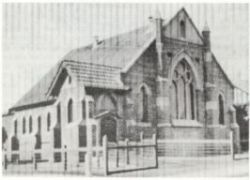
Congregational Church 1921 in Arkaringa Crescent, Black Rock. |
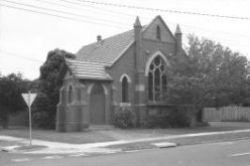
1986. Privately owned and operating as a ballet school. S055N35 |
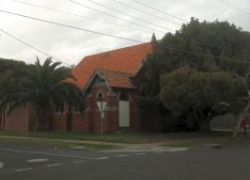
2013. The Cherill Rowston School of Ballet and School of Dance. |
During his years in Black Rock Frank painted beautiful religious works for the use of the Sunday School — the gentle Jesus embracing children of all races; the lions who spared the life of Daniel. He was church secretary from 1919 until he retired to Ferntree Gully in 1954.
1914: Methodist Church
In December 1914 the Brighton Circuit of the Methodist Church, comprising New, Male and Were Streets Brighton, Hampton & Sandringham, extended to include Black Rock by opening a Methodist Church on the Ebden Park Estate at the corner of Balcombe Rd and Central Avenue on Saturday 5th December 1914.
Rev. Adamson conducted the first service there the next day, Sunday 6th.
Because travelling by public transport on a Sunday was considered improper at that time and cars were few the preachers were faced with long walks or push bike rides along sandy tracks to the church. Indeed the ti-tree was so thick around the church, and the street lighting so sparse, that preachers often bypassed the church as they ventured along Balcombe Road.
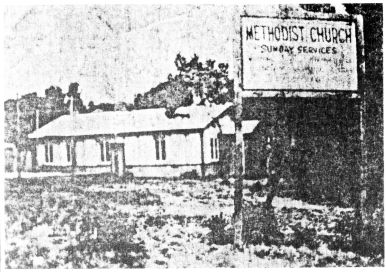
The Methodist Church in 1923 at the corner of Central Ave and Balcombe Rd. S078N08
A separate Sandringham Methodist Circuit was established in 1919 comprising Hampton, Sandringham and Black Rock.
The church building, a 32' x 20' wooden structure with ordinary house doors and windows, was rented for a small sum from the builders and owners, Messrs Will and Jack Edsall. It could accommodate 100 church goers, but could have been converted to a residence had the church not continued on that site. There were 13 members on the church roll.
Despite the difficulties of the dark years of World War 1, this property was purchased in 1918 for £475, by undertaking the repayment of a loan of £300.
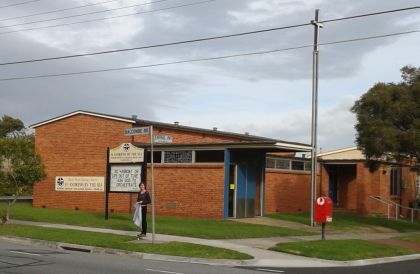
Methodist Church ⇒ St Andrews by the Sea. Central Ave and Balcombe Rd 2013.
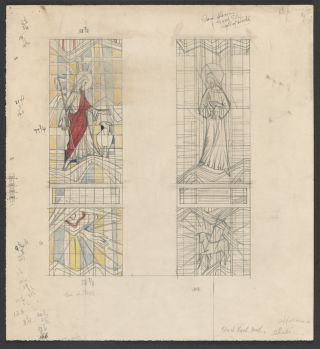
In the early 1960s, the Methodist Church at Black Rock commissioned Alan Sumner, a painter, silkscreen printer and stained glass designer and head of the National Gallery School from 1954 to 1962, to design stained glass windows for the Church. The picture shows one of two sketches that are in the State Library of Victoria.
1920: Presbyterian Church
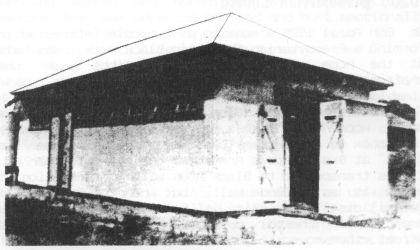
Presbyterian Church 1921 at 12 Second Street, Black Rock. The building came from Broadmeadows where it had been used as the local lockup.
On 8th April 1920 a meeting of eight people interested in forming a Presbyterian Church in Black Rock was held at the home of Councillor F N Gibbs under the chairmanship of the Rev. Hay.
The Presbyterian Home Mission Committee acquired a small wooden hall with a colourful past. Originally the annex to a suburban Town Hall, it next became “The Clink” at Broadmeadows Army Camp during World War 1. It was transported to Black Rock with the intention of using it as a Dance Hall, but when Sandringham Council disallowed this it became the Black Rock Presbyterian Church, originally situated in Second Street, then moved to 580 Balcombe Road in 1956.
The Presbyterian Church was opened on 23rd May 1920 by Rev. Smiley of Sandringham, Moderator of the charge. Rev. Hay was appointed to the Black Rock charge for six months at a stipend of £3 per week, half to be supplied by the Home Mission, the remainder by the congregation. The church was then known as "St. Andrews Presbyterian Church Black Rock". Thus the tradition for the title of "St. Andrews" began.
A joint committee appointed by the Boards of Management of the Cheltenham and Black Rock Presbyterian Churches first met on 5th February 1926 and this joint charge continued until 1st July 1947, after which Black Rock became a Home Mission Charge.
The Three Churches Combine
So now the three churches which were to combine in 1977 as the Uniting Church in Australia in Black Rock were all witnessing and ministering to the people of Black Rock. Strange to say, September 1920 was the first occasion on which those three denominations discussed the issue of church union, which did not occur for another 57 years!
On 19th November 1920 the Congregational Building Fund, begun in 1904, enabled the foundation stone to be laid for a brick church to be built at the corner of Arkaringa Crescent and Bent Parade. The completed building was opened the following year, and the several times enlarged original wooden building behind it became the Sunday School.
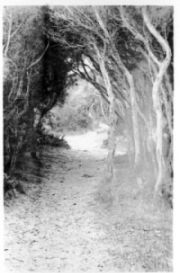
Path through the ti-tree, Black Rock c.1925–30. Real Photo Series M2485. S178N06
This original building was also used as a private school. An advertisement in "The Sandringham News" 23 February 1923 describes:
"Beachleigh College" at the Congregational Hall, Arkaringa Crescent, Black Rock. Boarding and day pupils taken from Kindergarten to Leaving Honours. Principal: Miss de Mumby."
[It appears that in 1918 there were both Beachleigh School in Thomas Street, and "Beachleigh" in Arkaringa Crescent; both with principal Miss A McCoughtry. (Brighton Southern Cross, 1918)]
These ambitious plans did not continue long enough for any to obtain "Leaving Honours", but under the tuition of Mrs Luker, a primary school known as "Wantage" flourished in the Congregational Hall for several years.
About this time an eight year old girl attended the Methodist Church for the very first time. The organist had failed to appear, so when a volunteer pianist was called for little Mavis Watkins obliged; after all, she had played the National Anthem at the Sandringham Town Hall. The same talented, modest musician, Mrs Mavis Durham, remains the dedicated church organist in 1990. She also has given countless hours of pleasure to many people as accompanist to the Sandringham Choral Society.
A united service of the Black Rock Congregational, Methodist and Presbyterian churches was held in the Methodists church on 7th December 1923 — the first of many occasions when the churches joined together in common purpose.
The next decade saw growth in all three churches. Sunday schools flourished, with the annual highlight being their anniversaries. Frequently two or three of the Sunday Schools joined with one another for part of their celebrations, and shared the musical talents and preachers of the district.
Of course Sunday School Picnics were held on Melbourne Cup Day, often within walking distance of the churches … e.g., the Methodists under a huge gum tree on "Cullinane Estate" (opposite the present Roman Catholic church in Balcolme Road), or amongst the wild flowers on Balcombe Heights (behind Beaumaris Primary School). The Congregationalists sometimes used the magnificent playing fields of Semco Park in Cheltenham Road. Berg's removal van ferried the children further afield — to the Zoo, Dromana, the Dandenongs and Bulla. As many as 100 children attended the picnics and up to three vans were needed to transport them.
On balmy summer evenings in the '30's beachgoers could often see a group of canoes circling just off Black Rock beach and hear teenage voices singing hymns and choruses while Mavis Watkins strummed an accompaniment on her Ukulele — a very early hint of the "Campaign for Christ" which the three churches were to conduct on the beaches in January 1943.
The Infantile Paralysis (poliomyelitis) Epidemic thoroughly disorganised Sunday School in 1937, along with the suffering it brought to the community at large, but all three Sunday Schools continued to thrive after the epidemic had passed.
The Congregationalists celebrated their "Golden Jubilee" in 1940. The Church Roll listed 60 members, with about 80 Sunday School scholars. The spirit of the occasion was expressed in a hymn:
OUR CHURCH BY THE SEA
Joyous is our Jubilee.
Suppliant we come to Thee
Thinking over happy days
Spent in service and in praise.
O Thou Christ of Galilee
Bless our Church beside the sea!
Thou didst work thy Father’s will
In the field, upon the hill;
By the lakeside, in the street,
O Thou Christ of Bethany,
Bless our Church by the sea.
In our restlessness and fear,
We are stilled if Thou art near.
Be our storm-lamp through the night,
Thou of all the world the Light.
O Thou Christ of Calvary,
Bless our Church beside the sea.
(Mrs Willett Bevan – 1940)
World War II brought trials, tragedies and testing times to the community and again the three churches were involved in supporting the troops and their families at home. The formation of a "Methodist Brotherhood" in 1946 reflects the caring and mateship which are the positive Christian attributes which emerge at such times.
Nurture of young people was provided by such organisations as the Presbyterian "Boys Brigade" who even had their own uniform. There were Methodist and Congregational Youth Fellowships, and "Pilots" who supported Missionary services in the South Pacific.
Cricket clubs, tennis clubs and visits to skating rinks also provided healthy activities for young people before the community at large catered so profusely for sporting activities.
The whole church family was regularly involved in concerts, garden parties, and social services such as visits to hospitals and shut-ins. Members of all three churches were among the founding supporters of Sandringham Community Hospital and have continued to actively support this fine institution through the years. Likewise Sandringham's "Meals on Wheels" relies heavily on their support.
On 22nd January 1943 the three churches combined to conduct their first "Open Air Campaign for Christ". Services were held at the beaches on Sunday afternoons during the summer season in order to reach some of the people for whom the lure of the beach and bay precluded orthodox church attendance.
In 1951 the terrors of the sea and the saving grace of Christ were poignantly reflected when a stained glass window depicting Jesus walking across the waves to the fishermen on Lake Galilee was unveiled in the Congregational Church as a memorial to Bart Hughes, a church member who had been lost at sea when the "Yarra" was sunk during the Java Sea Battle in March 1942.
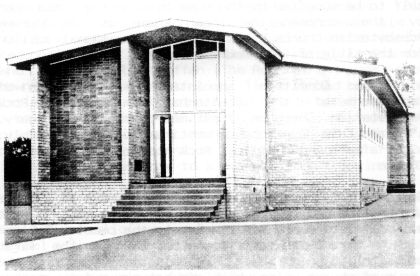
Presbyterian Church 1956 Balcombe Road opposite Ebden Avenue, Black Rock.
Music has always been an important and much loved part of worship in Black Rock. Many young men adept at rowing their boats on the bay used their well exercised muscles to pump air to the organ bellows for the church organist each Sunday. In 1951 a fine organ, originally presented by Dame Nellie Melba to the Burnley Congregational Church, was installed at the Black Rock Congregational Church. You can imagine the pride of the lads who pumped that organ!
A pre-school Play Centre opened in the Presbyterian Hall on 1st September 1955 with 30 children attending each week day. An enlarged multi-purpose building replacing the old hall was opened on Sunday 5th July 1959. While being used as a church for Sunday worship, this building continued to function as the pre-school centre during the week, as well as for week day church activities.
This was an era of upgrading buildings. In 1959 the present brick building at the corner of Central Avenue and Balcombe Road replaced the old wooden structure which became the Sunday School for the Methodists.
On 30th July 1961 the Presbyterians opened a new manse at the west of their church.
Soon after this, the many times enlarged wooden Congregational Hall was finally demolished to make way for a brick hall behind the church and this opened on 16th September 1962.
Building was not confined to bricks and mortar in Black Rock. When the Presbytery of Melbourne South opened and dedicated a church hall in Gibbs Street, Beaumaris on 14th April 1957, members of the Black Rock Presbyterian Church assisted by providing preachers when necessary.
In 1962 the Congregational Home Mission moved to establish a new church in the growing Cheltenham area using the proceeds of the sale of the Oxford Street, Brunswick, Congregational Church. Supported by the congregation the secretary of the Black Rock Congregational Church, Mr Peter Munster, was heavily involved in the development of this new cause. Black Rock supplied the pulpit, and indeed when the new fellowship was formalised as a church in 1964 it was as a joint pastorate with Black Rock. This arrangement continued until January 1971 when Cheltenham became a separate pastorate.
The year 1964 saw the Methodists celebrating their Golden Jubilee, and by 1968 discussions had begun with regard to the co-operation of the Methodists and Presbyterians who were worshipping so close to one another on either side of Balcombe Road. A unanimous vote on 6th July 1971 formalised this association.
1977: Uniting Church of Australia
On 23rd June 1977 the Uniting Church in Australia came into being and the three churches in Black Rock Parish came together as the Black Rock Uniting Church, meeting for worship in the former Methodist Building. The three strains from which this church emerged were commemorated in [November] 1984 by the adoption of the name "St. Andrews by the Sea".
The former Congregational property was sold in 1984 and the Presbyterian in 1986. Part of the proceeds of these sales was used to build a new manse and to replace the old wooden Methodist building with a fine suite of rooms for fellowship and service use.
In these comfortable, modern buildings the congregation, comprising members of all three founding denominations, met for worship, thanksgiving and fellowship on Sunday 29th April 1990 to celebrate the first century of this church’s service. They were not honouring the "buildings" but the "builders" who have worked steadfastly under God's guidance to do His will.
In honouring the pioneers, and enjoying the spiritual and physical comforts and strengths they have bequeathed, we look forward to future generations continuing in this tradition as builders of God's Kingdom.
Dawn Odgers 1990
– Ministers –
Congregational:
| 1890–1905 | Rev. | J Rickard | (from Brighton) |
| 1905–1910 | " | A H Wallace | |
| 1910–1917 | " | A G Turner | |
| 1917–1924 | " | H H Mills | |
| 1924–1926 | " | J Tonkin | |
| 1926–1933 | " | J H Trewella | |
| 1933–1937 | " | G King | |
| 1937–1943 | " | C G Forward | |
| 1943–1955 | " | F Collishaw | |
| 1955–1956 | " | A L Hill | |
| 1956–1963 | Pastor | W S Leech | |
| 1963–1968 | Rev. | A Searle | |
| 1968–1971 | " | W Lowry | |
| 1971–1979 | Pastor | W S Leech & Lay Preachers | |
| 1979–1985 | Rev. | T M O'Connor | (as U.C.A.) |
| 1985–1990 | " | J McOrist | (as U.C.A.) |
Methodist:
| 1914–1917 | Rev. | C W Atkinson | Brighton Circuit |
| 1917–1920 | " | F Delbridge | " " |
| 1920–1925 | " | S C Flockhart | Sandringham Circuit |
| 1925–1929 | " | W C Thomas | " " |
| 1929–1934 | " | W C Butler | " " |
| 1934–1938 | " | J H Langdon | " " |
| 1938–1939 | " | C J Walklate | " " |
| 1939–1943 | " | W J Williams | " " |
| 1943–1948 | " | M M Bennett | " " |
| 1948–1952 | " | R S Morris | " " |
| 1952–1954 | " | F C Boundy | " " |
| 1954–1959 | " | F I Fielding | " " |
| 1960–1961 | " | R F P Bye | " " |
| 1961–1964 | " | K H Cross | Black Rock |
| 1964–1969 | " | R G Golding | " " |
| 1969–1974 | " | L W Churchill | " " |
| 1974–1979 | " | D Poynton | (with Presbyterian) |
| 1979–1985 | " | T M O'Connor | (as U.C.A.) |
| 1985–1990 | " | J McOrist | (as U.C.A. |
Presbyterian:
| 1920–1921 | Rev. | J Hay | |
| 1921–1925 | " | F A Hagenaeur | (Joint Charge with Cheltenham) |
| 1925–1926 | " | W Kelly | |
| 1926–1941 | " | A J Porter | |
| 1942–1943 | " | W C White | |
| 1943–1947 | " | A W Ivory | |
| 1948–1949 | " | A Pye | (Home Mission) |
| 1949–1950 | " | S Dorman | |
| 1950–1952 | " | I Hackson | |
| 1952–1956 | " | Nicholson | |
| 1956–1959 | " | J G Scarfe | |
| 1959–1962 | " | W J Perry | |
| 1962–1963 | " | J Firth | (from Shetland Isles; exchange with Mr Perry) |
| 1963–1964 | " | W J Perry | |
| 1964–1971 | " | A Thomson | |
| 1974–1979 | " | D Poynton | (with Methodist) |
| 1979–1985 | " | T M O'Connor | (as U.C.A.) |
| 1985–1990 | " | J McOrist | (as U.C.A. |
– Chronology –
| 29.4.1890 | 1st Congregational Service (Seaview Crescent) | |
| Jan. 1891 | Land purchased and services begin in wooden building (corner Arkaringa Crescent and Bent Parade) | |
| 21.3.1910 | Black Rock Congregational Church formed | |
| 6.12.1914 | 1st Methodist Service (Ebden Park Estate) | |
| 12.1.1918 | Methodist property purchased (corner Central Avenue & Balcombe Road) | |
| 23.5.1920 | 1st Presbyterian Service (Second Street) | |
| 7.12.1923 | 1st Combined Congregational, Methodist and Presbyterian Service | |
| 5.7.1959 | St. Andrews Presbyterian Church opened (Balcombe Road) | |
| 6.7.1971 | Methodist and Presbyterian "Co-operation" formalised | |
| 23.6.1977 | United Church in Australia formed and Black Rock Congregational, Methodist and Presbyterian unite | |
| Nov.1984 | Name "St. Andrews by the Sea, Black Rock" adopted. |
